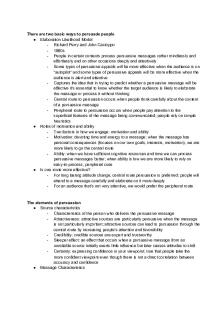Chapter 12: Social Psychology PDF

| Title | Chapter 12: Social Psychology |
|---|---|
| Course | Mind And Society >2 |
| Institution | University of Oregon |
| Pages | 3 |
| File Size | 60.1 KB |
| File Type | |
| Total Views | 143 |
Summary
Professor Jeffrey Measelle lecture notes from chapter 12....
Description
Lake Wobegon Effect (Better-than-Average Effect) o You systematically think you are better than average o We deceive ourselves (lack self-knowledge) We are prone to and maintain Self-Serving Biases: the tendency to overestimate situation-based explanations for the observed (negative) behaviors of ourselves Fundamental Attribution Error: the tendency to overestimate personality-based explanations for the observed (negative) behaviors of others o Is positive self-bias good? Some is okay, and even adaptive It helps us attain our goals and avoid depression (Taylor & Brown) Too much of anything is a bad thing We need to be realistic about self-progress Don't want to be a narcissist o Other self-biases: Spotlight Effect Biased attention: we seriously and systematically over estimate how much people notice us Tom Gilovich study o Why should we care about self-bias? Self-fulfilling prophecies People tend to behave in ways that conform their own or others' expectations Rosenthal Experiment: Teachers and IQ Pygmalion Effect: the greater the expectations on people, the better they perform Cognitive Dissonance Theory o Leon Festinger: cognitive dissonance occurs when there is a contradiction between two attitudes or between an attitude and a behavior Dissonance causes anxiety and tension; motivates you to reduce the dissonance You reduce dissonance by changing your attitudes or behaviors or you rationalize or trivialize the discrepancy Prejudice and Stereotyping o Stereotyping: attributing traits to members of a particular group o Prejudice: a negative attitude or negative affect toward a particular group and its members o Discrimination: treating members of a particular group differently (generally worse) because of their group membership Discrimination in Healthcare Doctors are 40% less likely to order sophisticated cardiac tests for women and black people who complain of chest pain than for men and white people with the same symptoms Doctors' IAT scores (a measure of implicit prejudice) predict their treatment recommendations 'Modern' and 'Benevolent' forms of prejudice
Modern racism (subtle racism): a rejection of explicit racism, but with ongoing, unacknowledged negative attitudes Benevolent racism/sexism/homophobia: "some of my best friends are.." People are 'okay' with/act positively toward members of another group so long as they conform to expectations Glick & Fiske (2001): benevolent sexism often coexists with hostile sexism o Causes of stereotypes and prejudice? Realistic conflict: frustration from competing with another group for scarce resources Economic competition is a driving force in the development or maintenance of negative intergroup attitudes People with the "most to lose" often show the greatest amount of prejudice and related aggression Us vs. Them - human tendency of in-group and out-group Social learning - it is taught and learned o Can people control their prejudice and stereotyping? Not very well Devine (2000) found that people low & high in prejudice often have similar automatic emotional reactions Low-prejudiced people "consciously" act to suppress prejudicial thoughts and feelings Stereotype threat: if participants are told that women are worse than men at mathematics, the women's scores worsen and the men's improve Prejudice = Implicit Attitudes o Automatic prejudice - everyone is prejudiced about something Rapid categorization of people Evolutionary linked skill - survival o Almost never benign Stereotypes support biased/racists/prejudiced attitudes that function automatically Reflexively cross street at sight of particular type of man Automatically attribute negative attitudes to people of different skin color, religious background, political learning, etc How do we measure something so automatic? o Implicit Association Test The IAT is a computer task that measures the strength of automatic, implicit, or unconscious associations between concepts The idea is that you're going to be quicker doing whichever classification best matches associations you already have Prejudice and Stereotypes II o How to combat prejudice and stereotypes? Recognize prejudice Control automatic prejudice Increase contact among prejudiced groups
Two groups must be almost equal in status View each other as typical of their respective group; not the exception Engage in cooperative, non competitive tasks Contact must be informal o Familiarity will decrease prejudice? Mere exposure effect: phenomenon by which people tend to develop a preference for things merely because they are familiar with them Summary o Prejudice and stereotype often exist at implicit levels (i.e., unconscious, fast acting) o Socially learned o Familiarity increases appreciation and lowers prejudice...
Similar Free PDFs

Chapter 12 Social Psychology
- 10 Pages

Chapter 12: Social Psychology
- 3 Pages

Chapter 12 Social Psychology
- 5 Pages

Chapter 13 Social Psychology
- 9 Pages

Social psychology chapter 8
- 6 Pages

Positive Psychology Chapter 12
- 4 Pages
Popular Institutions
- Tinajero National High School - Annex
- Politeknik Caltex Riau
- Yokohama City University
- SGT University
- University of Al-Qadisiyah
- Divine Word College of Vigan
- Techniek College Rotterdam
- Universidade de Santiago
- Universiti Teknologi MARA Cawangan Johor Kampus Pasir Gudang
- Poltekkes Kemenkes Yogyakarta
- Baguio City National High School
- Colegio san marcos
- preparatoria uno
- Centro de Bachillerato Tecnológico Industrial y de Servicios No. 107
- Dalian Maritime University
- Quang Trung Secondary School
- Colegio Tecnológico en Informática
- Corporación Regional de Educación Superior
- Grupo CEDVA
- Dar Al Uloom University
- Centro de Estudios Preuniversitarios de la Universidad Nacional de Ingeniería
- 上智大学
- Aakash International School, Nuna Majara
- San Felipe Neri Catholic School
- Kang Chiao International School - New Taipei City
- Misamis Occidental National High School
- Institución Educativa Escuela Normal Juan Ladrilleros
- Kolehiyo ng Pantukan
- Batanes State College
- Instituto Continental
- Sekolah Menengah Kejuruan Kesehatan Kaltara (Tarakan)
- Colegio de La Inmaculada Concepcion - Cebu









